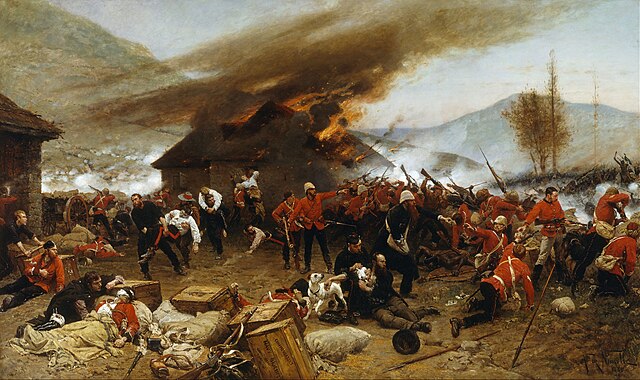- On Jan. 11, 1879, the British invaded Zululand after the Zulu king refused an ultimatum used to provoke a war.
- On Jan. 22, the British suffered a terrible defeat in the Battle of Isandlwana. Over 1,300 Brits were killed.
- A reserve unit of Zulu warriors that had not taken part in the Battle of Isandlwana, led by the Zulu kings younger half-brother, violated the king’s order to not cross the border into British territory. They wanted the glory they had not gotten at Isandlwana.
- The Zulu targeted a mission-station at Rorke’s Drift. The post was held by about 150 soldiers from the 24th It was commanded by Lt. Gonville Bromhead, who happened to be there as an engineer building a bridge over the nearby river. He supplanted Lt. John Chard who became his second in command. Chard and Bromhead considered evacuation, but were convinced by Assistant Commissary James Dalton to stay.
- The British used mealie bags, biscuit boxes, and crates of tinned meat to connect the buildings. There was also a wall that could be defended.
- When the Zulu approached, a unit of native cavalry and a unit of native soldiers fled with their British officers. The defenders opened fire on them and Corporal William Anderson was killed.
- The Zulu were armed with their famous short spears called assegai. They sometimes were thrown, but usually were used for stabbing. Some had muskets and some had British Martini-Henry rifles acquired at Isandlwana. The Zulu were very poor shots, however. Some warriors had clubs and all had oxhide oval shields. The British had the rifle plus bayonets.
- The Zulu launched piecemeal attacks that sometimes resulted in hand-to-hand combat (or rather, assegai to bayonet combat).
- The Zulu managed to get into the hospital building. British soldiers had to use their bayonets to open holes in the walls so they could escape to the next room. The building caught fire. Most of the soldiers, including hospitalized men, were able to escape.
- The British pulled back to the last line of mealie bags. Attacks continued through the night lit by the fire from the hospital. At 2 A.M., the attacks tapered off and by 4 A.M., the sniping ended.
- The British had lost a remarkably low 17 killed (5 by gunfire) and 15 wounded. It is estimated that the Zulu lost around 350 and 500 wounded. Some of the wounded were killed by British soldiers after the battle.
- 15 Victoria Crosses (equivalent to Medals of Honor) were awarded. This was the most for one unit in a battle. The V.C. recipients included Chard, Bromhead, and Dalton.
https://www.historyhit.com/facts-about-the-battle-of-rorkes-drift/
https://en.wikipedia.org/wiki/Battle_of_Rorke%27s_Drift
https://www.britishbattles.com/zulu-war/battle-of-rorkes-drift/

0 Comments